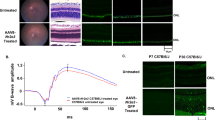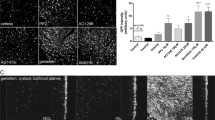Abstract
Gene transfer of neurotrophic or antiangiogenic factors has been shown to improve photoreceptor survival in retinal degenerative disorders (that is retinitis pigmentosa) and to prevent neovascularization in retinal vascular diseases (that is age-related macular degeneration, diabetic retinopathy). Expression of such neurotrophic or antiangiogenic factors after gene transfer requires the use of a regulatory system to control transgene expression to avoid unwanted side effects in cases of overexpression. In a previous study, we demonstrated that rAAV-mediated gene transfer of the tetracycline-regulatable (tetR) system allows transgene regulation in the retina of nonhuman primates after intravenous administration of doxycycline (Dox). The purpose of this study was to evaluate oral administration of Dox to control transgene expression in the retina, since the pharmacokinetics after oral administration of the inducer drug represent a key factor when considering advancing to clinical trials. We report on the outcome of this evaluation and demonstrate that oral administration of Dox at a dose that is clinically used in humans (5 mg kg−1 per day) is capable to continuously induce transgene expression in all macaques tested for 6 months. Moreover, control of transgene expression persists up to 4 years post-subretinal injection, with maximal induced levels of transgene product remaining stable over time.
This is a preview of subscription content, access via your institution
Access options
Subscribe to this journal
Receive 12 print issues and online access
$259.00 per year
only $21.58 per issue
Buy this article
- Purchase on Springer Link
- Instant access to full article PDF
Prices may be subject to local taxes which are calculated during checkout


Similar content being viewed by others
References
Hartong DT, Berson EL, Dryja TP . Retinitis pigmentosa. Lancet 2006; 368: 1795–1809.
Liang FQ, Aleman TS, Dejneka NS, Dudus L, Fisher KJ, Maguire AM et al. Long-term protection of retinal structure but not function using RAAV.CNTF in animal models of retinitis pigmentosa. Mol Ther 2001; 4: 461–472.
Liang FQ, Dejneka NS, Cohen DR, Krasnoperova NV, Lem J, Maguire AM et al. AAV-mediated delivery of ciliary neurotrophic factor prolongs photoreceptor survival in the rhodopsin knockout mouse. Mol Ther 2001; 3: 241–248.
Bok D, Yasumura D, Matthes MT, Ruiz A, Duncan JL, Chappelow AV et al. Effects of adeno-associated virus-vectored ciliary neurotrophic factor on retinal structure and function in mice with a P216L rds/peripherin mutation. Exp Eye Res 2002; 74: 719–735.
Schlichtenbrede FC, MacNeil A, Bainbridge JW, Tschernutter M, Thrasher AJ, Smith AJ et al. Intraocular gene delivery of ciliary neurotrophic factor results in significant loss of retinal function in normal mice and in the Prph2Rd2/Rd2 model of retinal degeneration. Gene Therapy 2003; 10: 523–527.
Buch PK, MacLaren RE, Duran Y, Balaggan KS, MacNeil A, Schlichtenbrede FC et al. In contrast to AAV-mediated Cntf expression, AAV-mediated Gdnf expression enhances gene replacement therapy in rodent models of retinal degeneration. Mol Ther 2006; 14: 700–709.
Tao W, Wen R, Goddard MB, Sherman SD, O'Rourke PJ, Stabila PF et al. Encapsulated cell-based delivery of CNTF reduces photoreceptor degeneration in animal models of retinitis pigmentosa. Invest Ophthalmol Vis Sci 2002; 43: 3292–3298.
Sieving PA, Caruso RC, Tao W, Coleman HR, Thompson DJ, Fullmer KR et al. Ciliary neurotrophic factor (CNTF) for human retinal degeneration: phase I trial of CNTF delivered by encapsulated cell intraocular implants. Proc Natl Acad Sci USA 2006; 103: 3896–3901.
Wen R, Song Y, Kjellstrom S, Tanikawa A, Liu Y, Li Y et al. Regulation of rod phototransduction machinery by ciliary neurotrophic factor. J Neurosci 2006; 26: 13523–13530.
Campochiaro PA . Retinal and choroidal neovascularization. J Cell Physiol 2000; 184: 301–310.
Aiello LP . Angiogenic pathways in diabetic retinopathy. N Engl J Med 2005; 353: 839–841.
Ferrara N, Kerbel RS . Angiogenesis as a therapeutic target. Nature 2005; 438: 967–974.
D'Amico DJ, Masonson HN, Patel M, Adamis AP, Cunningham Jr ET, Guyer DR et al. Pegaptanib sodium for neovascular age-related macular degeneration: two-year safety results of the two prospective, multicenter, controlled clinical trials. Ophthalmology 2006; 113: 992–1001.
Cunningham Jr ET, Adamis AP, Altaweel M, Aiello LP, Bressler NM, D'Amico DJ et al. A phase II randomized double-masked trial of pegaptanib, an anti-vascular endothelial growth factor aptamer, for diabetic macular edema. Ophthalmology 2005; 112: 1747–1757.
Rosenfeld PJ, Brown DM, Heier JS, Boyer DS, Kaiser PK, Chung CY et al. Ranibizumab for neovascular age-related macular degeneration. N Engl J Med 2006; 355: 1419–1431.
Brown DM, Kaiser PK, Michels M, Soubrane G, Heier JS, Kim RY et al. Ranibizumab versus verteporfin for neovascular age-related macular degeneration. N Engl J Med 2006; 355: 1432–1444.
Bashshur ZF, Bazarbachi A, Schakal A, Haddad ZA, El Haibi CP, Noureddin BN . Intravitreal bevacizumab for the management of choroidal neovascularization in age-related macular degeneration. Am J Ophthalmol 2006; 142: 1–9.
Jager RD, Aiello LP, Patel SC, Cunningham Jr ET . Risks of intravitreous injection: a comprehensive review. Retina 2004; 24: 676–698.
Raisler BJ, Berns KI, Grant MB, Beliaev D, Hauswirth WW . Adeno-associated virus type-2 expression of pigmented epithelium-derived factor or Kringles 1–3 of angiostatin reduce retinal neovascularization. Proc Natl Acad Sci USA 2002; 99: 8909–8914.
Auricchio A, Behling KC, Maguire AM, O'Connor EM, Bennett J, Wilson JM et al. Inhibition of retinal neovascularization by intraocular viral-mediated delivery of anti-angiogenic agents. Mol Ther 2002; 6: 490–494.
Mori K, Gehlbach P, Yamamoto S, Duh E, Zack DJ, Li Q et al. AAV-mediated gene transfer of pigment epithelium-derived factor inhibits choroidal neovascularization. Invest Ophthalmol Vis Sci 2002; 43: 1994–2000.
Bainbridge JW, Mistry A, De Alwis M, Paleolog E, Baker A, Thrasher AJ et al. Inhibition of retinal neovascularisation by gene transfer of soluble VEGF receptor sFlt-1. Gene Therapy 2002; 9: 320–326.
Lai YK, Shen WY, Brankov M, Lai CM, Constable IJ, Rakoczy PE . Potential long-term inhibition of ocular neovascularisation by recombinant adeno-associated virus-mediated secretion gene therapy. Gene Therapy 2002; 9: 804–813.
Ideno J, Mizukami H, Kakehashi A, Saito Y, Okada T, Urabe M et al. Prevention of diabetic retinopathy by intraocular soluble flt-1 gene transfer in a spontaneously diabetic rat model. Int J Mol Med 2007; 19: 75–79.
Deng WT, Yan Z, Dinculescu A, Pang J, Teusner JT, Cortez NG et al. Adeno-associated virus-mediated expression of vascular endothelial growth factor peptides inhibits retinal neovascularization in a mouse model of oxygen-induced retinopathy. Hum Gene Ther 2005; 16: 1247–1254.
Campochiaro PA . Gene therapy for ocular neovascularization. Curr Gene Ther 2007; 7: 25–33.
Storkebaum E, Carmeliet P . VEGF: a critical player in neurodegeneration. J Clin Invest 2004; 113: 14–18.
Stieger K, Le Meur G, Lasne F, Weber M, Deschamps JY, Nivard D et al. Long-term doxycycline-regulated transgene expression in the retina of nonhuman primates following subretinal injection of recombinant AAV vectors. Mol Ther 2006; 13: 967–975.
Chenuaud P, Larcher T, Rabinowitz JE, Provost N, Joussemet B, Bujard H et al. Optimal design of a single recombinant adeno-associated virus derived from serotypes 1 and 2 to achieve more tightly regulated transgene expression from nonhuman primate muscle. Mol Ther 2004; 9: 410–418.
Salvetti A, Oreve S, Chadeuf G, Favre D, Cherel Y, Champion-Arnaud P et al. Factors influencing recombinant adeno-associated virus production. Hum Gene Ther 1998; 9: 695–706.
Weber M, Rabinowitz J, Provost N, Conrath H, Folliot S, Briot D et al. Recombinant adeno-associated virus serotype 4 mediates unique and exclusive long-term transduction of retinal pigmented epithelium in rat, dog, and nonhuman primate after subretinal delivery. Mol Ther 2003; 7: 774–781.
McGee Sanftner LH, Rendahl KG, Quiroz D, Coyne M, Ladner M, Manning WC et al. Recombinant AAV-mediated delivery of a tet-inducible reporter gene to the rat retina. Mol Ther 2001; 3: 688–696.
Favre D, Blouin V, Provost N, Spisek R, Porrot F, Bohl D et al. Lack of an immune response against the tetracycline-dependent transactivator correlates with long-term doxycycline-regulated transgene expression in nonhuman primates after intramuscular injection of recombinant adeno-associated virus. J Virol 2002; 76: 11605–11611.
Klein NC, Cunha BA . New uses of older antibiotics. Med Clin North Am 2001; 85: 125–132.
Kelly DJ, Chulay JD, Mikesell P, Friedlander AM . Serum concentrations of penicillin, doxycycline, and ciprofloxacin during prolonged therapy in rhesus monkeys. J Infect Dis 1992; 166: 1184–1187.
Rivera VM, Gao GP, Grant RL, Schnell MA, Zoltick PW, Rozamus LW et al. Long-term pharmacologically regulated expression of erythropoietin in primates following AAV-mediated gene transfer. Blood 2005; 105: 1424–1430.
Acknowledgements
We thank Matthew Ellinwood for critical reading and editing. We also thank the Vector Core (www.vectors.nantes.inserm.fr) at the University Hospital of Nantes, supported by the Association Française contre les Myopathies (AFM), the INSERM, and the Fondation pour la Thérapie Génique en Pays de la Loire. This work was also supported by the French Lions Club and the Lions Clubs International Foundation (LCIF).
Author information
Authors and Affiliations
Corresponding author
Rights and permissions
About this article
Cite this article
Stieger, K., Mendes-Madeira, A., Meur, G. et al. Oral administration of doxycycline allows tight control of transgene expression: a key step towards gene therapy of retinal diseases. Gene Ther 14, 1668–1673 (2007). https://doi.org/10.1038/sj.gt.3303034
Received:
Revised:
Accepted:
Published:
Issue Date:
DOI: https://doi.org/10.1038/sj.gt.3303034
Keywords
This article is cited by
-
Investigational Agents in Development for the Treatment of Geographic Atrophy Secondary to Age-Related Macular Degeneration
BioDrugs (2021)
-
A regulatable AAV vector mediating GDNF biological effects at clinically-approved sub-antimicrobial doxycycline doses
Molecular Therapy - Methods & Clinical Development (2016)
-
Complement pathway biomarkers and age-related macular degeneration
Eye (2016)
-
A controlled double-duration inducible gene expression system for cartilage tissue engineering
Scientific Reports (2016)
-
Prolonged regulatable expression of EPO from an HSV vector using the LAP2 promoter element
Gene Therapy (2012)



